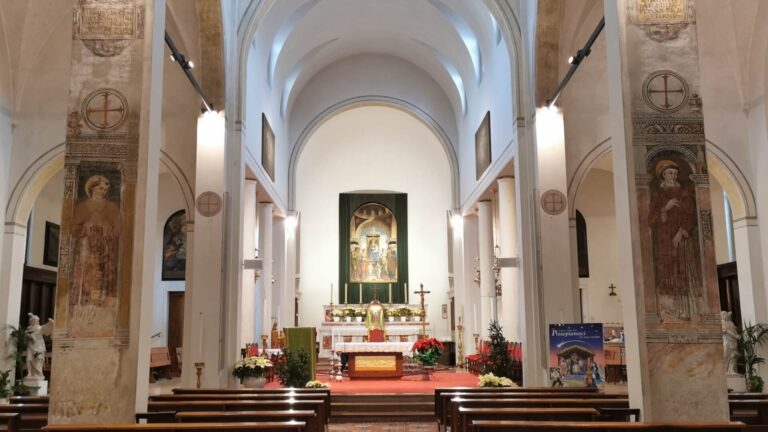ARTISTS’ ROADS
LE VIE DEGLI ARTISTI
watch the videos at the bottom of the page!
CONEGLIANO
The Holy Conversation by Cima da Conegliano: A Meeting Between Earth and Heaven
Within a monumental space, in a crystalline and composed atmosphere, earth and heaven, human and divine, matter and spirit, all come together.
The architectural setting for this encounter is the presbytery of a church. And the painter invites us to join in. He constructs it with strong perspective, leading us into the scene. He paints only a portion. He leaves the rest for us to imagine above our heads.
Square and circle define the architecture. The square shapes the ground plan, and marks the pattern of the floor. A reminder of the finiteness of the earth. The circle recurs in the dome, in its little windows, in the arches on which it rests, and in the rounded top of the altarpiece. It is the emblem of perfection, of the celestial vault. It is a sign of the spiritual realm.
And in this painting, heaven is truly there. It replaces the church’s apse. More than a presence, it becomes an aspiration. A fragment of Paradise.
And the “gateway” to heaven is Mary.
Cima da Conegliano, the painter of the altarpiece, makes this truth of faith explicit, placing the Virgin and her Child on a lofty marble throne that rises into the heavenly blue.
She is the heart of the composition. The sacred image is dedicated to her.
Below, six saints stand solemn. Their gazes intense, their features distinct. Their hands are like musical notes laid on a staff. They convey gestures and postures.
This Sacred Conversation includes John the Baptist and the apostle Peter, Catherine of Alexandria and Apollonia, Nicholas of Bari and Francis of Assisi.
It was 1492. Cima da Conegliano painted this masterpiece for his native town. It was destined for the high altar of the Church of Santa Maria dei Battuti, which had been rebuilt and consecrated on the 6th of June the year before. The wardens of the confraternity commissioned it with determination and pride.
By then, Cima was already a distinguished painter, living in Venice, Europe’s capital of art. There, Gentile and Giovanni Bellini were active. Giovanni had been his teacher. Also present were Vivarini, Carpaccio, and Giorgione.
And in this altarpiece, Venice is indeed present. The architectural space is an homage to San Marco, then the Doge’s chapel.
Some textile details, such as Saint Catherine’s sandals and the Turkish-style carpet, offer glimpses into the culture and taste of this cosmopolitan city at the turn of the century.
It was a city where music played a central role. And even this altarpiece is enlivened by it. The notes come from a lute and a rebec, played by two angels.
And then there are the refined and radiant marble elements, carefully balanced in colour and in rare varieties: a nod to antiquity, in line with Venetian cultural tastes of the time.
The figures are finely drawn and sculpted. Painted sculptures, reminiscent of the work of Antonio and Tullio Lombardo.
Look closely. Another figure appears. It is Saint Leonard of Limoges, depicted as a fine embroidery on Saint Nicholas’s cope. But this is no mere ornament. It is a historical marker, a glance towards origins. For Saint Leonard was the patron of the old parish church on the hilltop, the mother church of this very one.
At the foot of the throne lies a small sheet of paper. Its creases are visible. It bears the name of the artist, the names of the patrons Francesco Codroipo and Giovanni della Pasqualina, and the year the altarpiece painting was installed: 1493.
Thus, a truly groundbreaking work comes home to Conegliano.
MORE EXPERIENCES!
Oltre un secolo di pale d’altare:
- Tiziano Vecellio nel duomo di Serravalle
- Francesco Beccaruzzi nell’arcipretale di Mareno di Piave
- Gaspare Narvesa nella parrocchiale di Orsago
- Il Pordenone nell’arcipretale di Susegana
MULTIMEDIAL MAP: “ARTISTS’ ROADS – LE VIE DEGLI ARTISTI- EN”!

